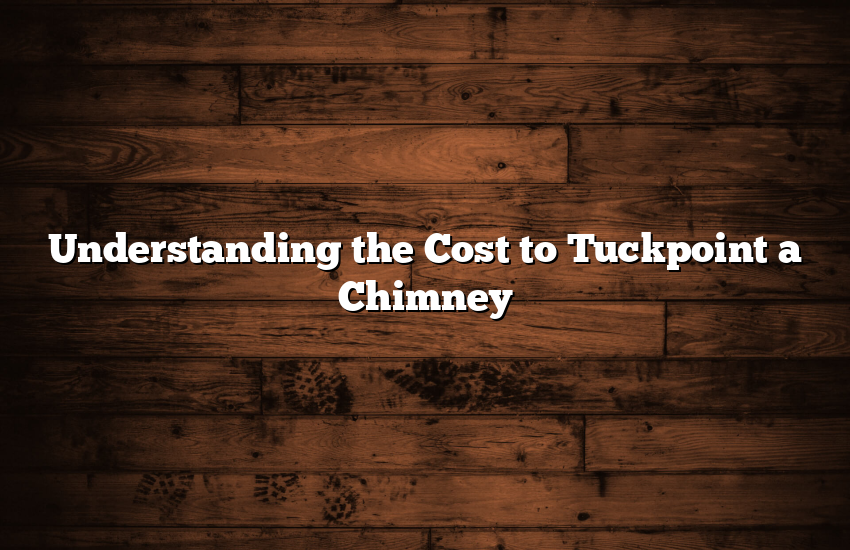
When it comes to maintaining your home, the chimney is an often overlooked but crucial component. Tuckpointing, a vital maintenance process for any brick chimney, involves repairing and replacing the mortar between bricks to ensure structural integrity and prevent water damage. Understanding the cost to tuckpoint a chimney is essential for homeowners, as it not only preserves the longevity of the chimney but also safeguards the overall well-being of their home. This article delves into the various factors that influence the cost of tuckpointing, providing you with the knowledge to make informed decisions about this important home maintenance task.
Table of Contents
Understanding Tuckpointing and Its Necessity
Definition of Tuckpointing
Tuckpointing is a masonry repair process that involves renewing the mortar joints between bricks or stones. This technique not only enhances the structural stability of a chimney but also improves its aesthetic appeal. Over time, mortar joints can decay due to weathering and erosion, making tuckpointing a necessary maintenance step.
Signs Your Chimney Needs Tuckpointing
Identifying the need for tuckpointing is crucial. Some tell-tale signs include:
- Eroding or crumbling mortar.
- Visible cracks within the mortar.
- Loose bricks or a weakened chimney structure.
- Water leakage inside the home near the chimney.
- A white powdery substance (efflorescence) on the chimney’s exterior.
Benefits of Tuckpointing
Tuckpointing offers several benefits:
- Enhances the longevity and durability of the chimney.
- Prevents water infiltration and associated damage.
- Improves heating efficiency by ensuring proper chimney function.
- Increases property value by maintaining the home’s exterior.
Factors Influencing the Cost to Tuckpoint Chimney
Size and Height of the Chimney
The larger and taller the chimney, the more labor-intensive and costly the tuckpointing process. Access to higher chimneys may require additional equipment, impacting the overall cost.
Extent of Damage and Repair Needed
The cost directly correlates with the extent of damage. Minor repairs are less expensive compared to extensive mortar deterioration, which requires more time and materials.
Choice of Materials
The type of mortar used can affect the cost. Specialty or color-matched mortars may be more expensive than standard options.
Geographic Location and Labor Costs
Prices vary depending on the local market. Urban areas typically have higher labor costs compared to rural areas.
Average Costs and Pricing Breakdown
National Average Costs for Tuckpointing
The cost of tuckpointing a chimney can vary widely across the United States. The national average will be discussed, providing a general cost framework.
Price Comparison by Regions
Costs can differ based on regional factors such as climate, availability of materials, and local labor rates. This section will offer a comparative analysis across various U.S. regions.
Additional Costs: Inspection and Permits
Beyond the actual tuckpointing, additional costs may include chimney inspections and any necessary permits. These factors can add to the total expense.
Choosing the Right Professional for Tuckpointing
Qualifications of a Chimney Repair Specialist
Ensuring the contractor’s qualifications is crucial. Key aspects include licensing, insurance, and experience in chimney repairs and tuckpointing.
Questions to Ask a Potential Contractor
Before hiring, consider asking:
- How long have you been doing tuckpointing?
- Can you provide references or before-and-after photos?
- What does your quote include, and are there potential additional costs?
Understanding the Quotation Process
A detailed quote should include a breakdown of labor, materials, and any additional fees. Transparency in the quotation process is essential for trust and budget planning.
DIY vs. Professional Tuckpointing: A Cost Analysis
Pros and Cons of DIY Tuckpointing
DIY tuckpointing might save money upfront but requires skill, proper tools, and time. Mistakes in DIY projects can lead to more significant issues, necessitating professional repairs.
When to Call a Professional
Professional help is recommended for complex or high-risk situations, ensuring safety and quality.
Safety Considerations and Tools Needed for DIY
Essential tools for DIY tuckpointing include a trowel, hammer, chisel, and mortar mix. Safety gear like gloves, goggles, and a dust mask is vital to protect against debris and dust.
Long-Term Savings and Value of Tuckpointing
Impact on Property Value
Well-maintained chimneys through regular tuckpointing can enhance a property’s aesthetic appeal and market value.
Preventative Measures and Long-Term Savings
Regular inspections and timely tuckpointing can prevent costly repairs in the future, leading to long-term savings.
Maintenance Tips to Extend Chimney Life
Regular maintenance includes:
- Annual chimney inspections.
- Cleaning the chimney to remove soot and debris.
- Addressing minor issues promptly to prevent them from escalating.
Conclusion:
In conclusion, tuckpointing is a vital aspect of chimney maintenance that should not be neglected. While the cost to tuckpoint a chimney can vary based on several factors, including the size of the chimney, the extent of damage, and regional labor costs, investing in this process is essential for the longevity and safety of your home. By understanding the nuances of tuckpointing costs, choosing the right professional, and considering long-term savings, homeowners can ensure their chimneys remain in good condition, contributing to the overall value and safety of their property.
FAQs:
Q: What is the average cost to tuckpoint a chimney?
A: The average cost varies but typically ranges from a few hundred to several thousand dollars, depending on factors like chimney size and repair extent.
Q: How often should my chimney be tuckpointed?
A: Generally, a chimney should be inspected every year and tuckpointed as needed, usually every 20-30 years.
Q: Can I tuckpoint my chimney myself?
A: While DIY tuckpointing is possible, it requires specific skills and tools. It’s often safer and more effective to hire a professional, especially for extensive work.
Q: What factors increase the cost of tuckpointing?
A: Factors include the size and height of the chimney, the severity of mortar damage, the type of materials used, and local labor costs.
Q: Does tuckpointing add value to my home?
A: Yes, tuckpointing can increase your home’s value by improving structural integrity, preventing water damage, and enhancing aesthetic appeal.


